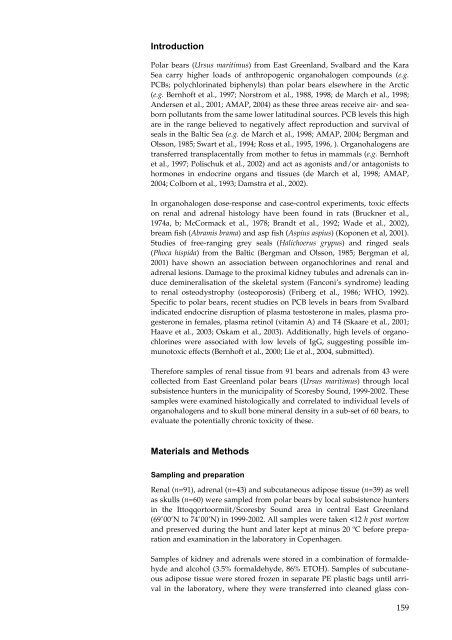Organohalogen concentrations and a gross and histologic ...
Organohalogen concentrations and a gross and histologic ...
Organohalogen concentrations and a gross and histologic ...
You also want an ePaper? Increase the reach of your titles
YUMPU automatically turns print PDFs into web optimized ePapers that Google loves.
Introduction<br />
Polar bears (Ursus maritimus) from East Greenl<strong>and</strong>, Svalbard <strong>and</strong> the Kara<br />
Sea carry higher loads of anthropogenic organohalogen compounds (e.g.<br />
PCBs; polychlorinated biphenyls) than polar bears elsewhere in the Arctic<br />
(e.g. Bernhoft et al., 1997; Norstrom et al., 1988, 1998; de March et al., 1998;<br />
Andersen et al., 2001; AMAP, 2004) as these three areas receive air- <strong>and</strong> seaborn<br />
pollutants from the same lower latitudinal sources. PCB levels this high<br />
are in the range believed to negatively affect reproduction <strong>and</strong> survival of<br />
seals in the Baltic Sea (e.g. de March et al., 1998; AMAP, 2004; Bergman <strong>and</strong><br />
Olsson, 1985; Swart et al., 1994; Ross et al., 1995, 1996, ). <strong>Organohalogen</strong>s are<br />
transferred transplacentally from mother to fetus in mammals (e.g. Bernhoft<br />
et al., 1997; Polischuk et al., 2002) <strong>and</strong> act as agonists <strong>and</strong>/or antagonists to<br />
hormones in endocrine organs <strong>and</strong> tissues (de March et al, 1998; AMAP,<br />
2004; Colborn et al., 1993; Damstra et al., 2002).<br />
In organohalogen dose-response <strong>and</strong> case-control experiments, toxic effects<br />
on renal <strong>and</strong> adrenal histology have been found in rats (Bruckner et al.,<br />
1974a, b; McCormack et al., 1978; Br<strong>and</strong>t et al., 1992; Wade et al., 2002),<br />
bream fish (Abramis brama) <strong>and</strong> asp fish (Aspius aspius) (Koponen et al, 2001).<br />
Studies of free-ranging grey seals (Halichoerus grypus) <strong>and</strong> ringed seals<br />
(Phoca hispida) from the Baltic (Bergman <strong>and</strong> Olsson, 1985; Bergman et al,<br />
2001) have shown an association between organochlorines <strong>and</strong> renal <strong>and</strong><br />
adrenal lesions. Damage to the proximal kidney tubules <strong>and</strong> adrenals can induce<br />
demineralisation of the skeletal system (Fanconi’s syndrome) leading<br />
to renal osteodystrophy (osteoporosis) (Friberg et al., 1986; WHO, 1992).<br />
Specific to polar bears, recent studies on PCB levels in bears from Svalbard<br />
indicated endocrine disruption of plasma testosterone in males, plasma progesterone<br />
in females, plasma retinol (vitamin A) <strong>and</strong> T4 (Skaare et al., 2001;<br />
Haave et al., 2003; Oskam et al., 2003). Additionally, high levels of organochlorines<br />
were associated with low levels of IgG, suggesting possible immunotoxic<br />
effects (Bernhoft et al., 2000; Lie et al., 2004, submitted).<br />
Therefore samples of renal tissue from 91 bears <strong>and</strong> adrenals from 43 were<br />
collected from East Greenl<strong>and</strong> polar bears (Ursus maritimus) through local<br />
subsistence hunters in the municipality of Scoresby Sound, 1999-2002. These<br />
samples were examined <strong>histologic</strong>ally <strong>and</strong> correlated to individual levels of<br />
organohalogens <strong>and</strong> to skull bone mineral density in a sub-set of 60 bears, to<br />
evaluate the potentially chronic toxicity of these.<br />
Materials <strong>and</strong> Methods<br />
Sampling <strong>and</strong> preparation<br />
Renal (n=91), adrenal (n=43) <strong>and</strong> subcutaneous adipose tissue (n=39) as well<br />
as skulls (n=60) were sampled from polar bears by local subsistence hunters<br />
in the Ittoqqortoormiit/Scoresby Sound area in central East Greenl<strong>and</strong><br />
(69˚00’N to 74˚00’N) in 1999-2002. All samples were taken

















